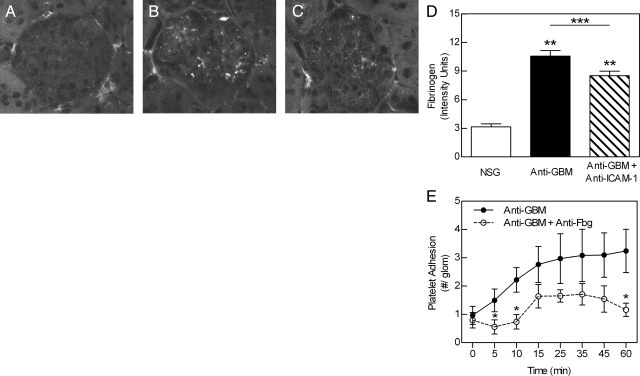Figure 6.
Endogenous fibrinogen accumulates within the glomerulus in response to anti-GBM antibody and promotes platelet adhesion. A–D: Role of ICAM-1 in fibrinogen accumulation. Mice were treated with either NSG, anti-GBM antibody (20 mg, i.v.), or anti-GBM antibody following pretreatment with a mAb against ICAM-1, and the kidneys were removed after 1 hour. Kidney sections were stained for fibrinogen using FITC-conjugated anti-mouse fibrinogen antibody. Minimal glomerular fibrinogen deposition was observed in NSG-treated mice (A), whereas extensive deposits of fibrinogen were detectable in glomeruli of anti-GBM antibody-treated mice (B). In mice treated with anti-ICAM-1 (C), the intensity of fibrinogen staining was reduced relative to mice treated with anti-GBM antibody alone. D: Mean intensity of glomerular fibrinogen staining in mice treated with NSG (n = 6), anti-GBM antibody alone (n = 9), and anti-GBM antibody plus anti-ICAM-1 (n = 9), as assessed using image analysis. Data were assessed in >25 glomeruli per animal and are shown as mean ± SEM. **P < 0.0001 versus NSG-treated mice. ***P < 0.01 versus mice treated with anti-GBM antibody alone. E: To assess the role of fibrinogen in glomerular platelet recruitment, mice were pretreated with a function-blocking antibody against mouse fibrinogen (n = 6) before assessment of anti-GBM antibody-induced platelet recruitment. Data were compared with that of mice treated with anti-GBM antibody alone (n = 6). Data are shown as mean ± SEM. *P < 0.05 versus anti-GBM antibody-treated group for the time points indicated.

